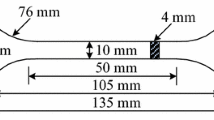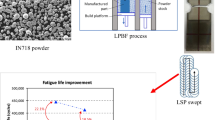Abstract
Thanks to Laser Powder Bed Fusion (L-PBF) technology, SCALMALLOY® was the first aluminum powder material designed for Additive Manufacturing (AM), achieving a fine microstructure with high performance that is comparable to other cast materials. Despite the mechanical properties that can be achieved, there are some inherent factors that can impede components performance (i.e., surface roughness). Parts produced by L-PBF are usually characterized by rough “as-built” surfaces; hence, it is fundamental during the design phase to understand and consider how the quality of surfaces impacts on the part performance. This paper aims to provide a Computer-Aided Engineering (CAE) workflow to design components with different finishing regions in accordance with the functional distinction that exists among them. To achieve this goal, a comparison of the mechanical properties achieved for SCALMALLOY® specimens with and without post-processing is here assessed to fit proper material models for numerical simulation purposes. The material models, built with/from experimental data, are fit to functionally adapt the performance of 3D-printed objects inside CAE simulations like a Functionally Graded Material (FGM). A CAE design workflow is here applied to a case study, suitable to demonstrate how the methodology may support the integrated product–process design of structural parts reducing the cost of post-processing in AM. This approach may mitigate the performance decrease of “as-built” surfaces since the experimental results show a different fatigue endurance limit between the “as-built” and CNC machined specimens about of three times.






















Similar content being viewed by others
References
Aversa A, Marchese G, Saboori A, Bassini E, Manfredi D, Biamino S, Ugues D, Fino P, Lombardi M (2019) New aluminum alloys specifically designed for laser powder bed fusion: a review. Materials 12(7):1007. https://doi.org/10.3390/ma12071007
Tradowsky U, White J, Ward RM, Read N, Reimers W, Attallah MM (2016) Selective laser melting of AlSi10Mg: influence of post-processing on the microstructural and tensile properties development. Mater Des 105:212–222. https://doi.org/10.1016/j.matdes.2016.05.066
Lasagni F, Galleguillos C, Herrera M et al (2021) On the processability and mechanical behavior of Al–Mg–Sc alloy for PBF-LB. Addit Manuf Prog. https://doi.org/10.1007/s40964-021-00216-z
Carpenter Additive, SCALMALLOY® datasheet powder material. https://www.carpenteradditive.com/Resources
Yali L, Dongdong G (2014) Parametric analysis of thermal behavior during selective laser melting additive manufacturing of aluminum alloy powder. Mater Des 63:856–867. https://doi.org/10.1016/j.matdes.2014.07.006
Carpenter Additive, AlSi10Mg datasheet powder material. https://www.carpenteradditive.com/Resources
Mauduit A, Pillot S, Gransac H, Mauduit A, Pillot S, Gransac H (2017) Study of the suitability of aluminum alloys for additive manufacturing by laser powder- bed fusion. U.P.B. Sci Bull Ser B 79(4)
Awd M, Tenkamp J, Hirtler M, Siddique S, Bambach M, Walther F (2018) Comparison of microstructure and mechanical properties of Scalmalloy® PRODUCED BY SELECTIVE LASER MELTING AND LASER METAL DEPOSITion. Materials 11(1):17. https://doi.org/10.3390/ma11010017
Fiocchi J, Tuissi A, Biffi CA (2021) Heat treatment of aluminium alloys produced by laser powder bed fusion: a review. Mater Des 204:109651. https://doi.org/10.1016/j.matdes.2021.109651
Isaac JP, Lee S, Shamsaei N, Tippur HV (2021) Dynamic fracture behavior of additively manufactured Scalmalloy®: effects of build orientation, heat-treatment and loading-rate. Mater Sci Eng, A 826:141978. https://doi.org/10.1016/j.msea.2021.141978
Molaei R, Fatemi A (2018) Fatigue design with additive manufactured metals: issues to consider and perspective for future research. Procedia Eng 213:5–16. https://doi.org/10.1016/j.proeng.2018.02.002
Musekamp J, Reiber T, Hoche HC, Oechsner M, Weigold M, Abel E (2021) Influence of LPBF-surface characteristics on fatigue properties of Scalmalloy®. Metals 11:1961. https://doi.org/10.3390/met11121961
Nezhadfar PD, Thompson S, Saharan A, Phan N, Shamsaei N (2021) Structural integrity of additively manufactured aluminum alloys: effects of build orientation on microstructure, porosity, and fatigue behavior. Addit Manuf. https://doi.org/10.1016/j.addma.2021.102292
EN ISO 25178–606:2015, Geometrical product specifications (GPS) - Surface texture: Areal - Part 606: Nominal characteristics of non-contact (focus variation) instruments
Kuisat F, Lasagni F, Lasagni AF (2021) Smoothing additive manufactured parts using ns-pulsed laser radiation. Prog Addit Manuf 6:297–306. https://doi.org/10.1007/s40964-021-00168-4
Obilanade D, Dordlofva C, Törlind P (2021) Surface roughness considerations in design for additive manufacturing - A literature review. Proceedings of the design society 1:2841–2850. https://doi.org/10.1017/pds.2021.545
Yan L et al (2020) A review on functionally graded materials and structures via additive manufacturing: from multi-scale design to versatile functional properties. Adv Mater Technol. https://doi.org/10.1002/admt.201900981
Kou XY, Tan ST (2007) A systematic approach for integrated computer-aided design and finite element analysis of functionally-graded-material objects. Mater Des 28(10):2549–2565. https://doi.org/10.1016/j.matdes.2006.10.024
Martínez-Pañeda E (2019) On the finite element implementation of functionally graded materials. Materials 12:287. https://doi.org/10.3390/ma12020287
Kim J, Paulino GH (2002) Isoparametric graded finite elements for nonhomogeneous isotropic and orthotropic materials. ASME J Appl Mech 69(4):502–514. https://doi.org/10.1115/1.1467094
Santare MH, Lambros J (2000) Use of graded finite elements to model the behavior of nonhomogeneous materials. ASME J Appl Mech 67(4):819–822. https://doi.org/10.1115/1.1328089
Koteswara RD, Blessington PJ, Tarapada R (2012) Finite element modeling and analysis of functionally graded composite shell structures. Procedia Eng 38:3192–3199. https://doi.org/10.1016/j.proeng.2012.06.370
Sufiiarov VS et al (2021) Computer modelling of uniaxial tension of functionally gradient material produced by additive manufacturing. Tech Phys 66(1):23
Mancini E, Campana F, Pilone D, Amodio D, Sasso M (2022) Definition of a unified material model for cellular materials with high morphological and topological dispersion: application to an AA7075-T6 aluminium foam. Mater Sci Eng, A 833:142346. https://doi.org/10.1016/j.msea.2021.142346
Ameta G, Witherell P (2019) Representation of graded materials and structures to support tolerance specification for additive manufacturing application. ASME J Comput Inf Sci Eng 19(2):021008. https://doi.org/10.1115/1.4042327
ASTM E8/E8M, Standard Test Methods for Tension Testing of Metallic Materials, 2021.
ASTM E466, Standard Practice for Conducting Force Controlled Constant Amplitude Axial Fatigue Tests of Metallic Materials, 2021.
Koutny D, Skulina D, Pantělejev L, Paloušek D, Lenczowski B, Palm F, Nick A (2018) Al-Sc aluminum alloy using SLM technology. Procedia CIRP 74:44–48. https://doi.org/10.1016/j.procir.2018.08.027
Huang K, Feng Q, Zhou W, Huang L, Xiang J, Luo N, Han K, Zhu Y, Wei Y (2021) Effects of Sc addition on microstructure, mechanical and corrosion resistance properties of 7055 Al alloy. Mater Res Express. https://doi.org/10.1088/2053-1591/abf9fa
J. Shigley, R. Budynas, J. Keith, Mechanical Engineering Design, McGraw-Hill, 2014.
Kleemann S, Fröhlich T, Türck E, Vietor T (20217) A methodological approach towards multi-material design of automotive components. Procedia CIRP 60: 68–73. https://doi.org/10.1016/j.procir.2017.01.010
Kamaya M (2016) Ramberg-Osgood type stress–strain curve estimation using yield and ultimate strengths for failure assessments. Int J Press Vessels Pip 137:1–12. https://doi.org/10.1016/j.ijpvp.2015.04.001
Zhao T, Cai W, Dahmen M, Schaible J, Hong C, Gasser A, Weisheit A, Biermann T, Kelbassa I, Zhang H, Gu D, Schleifenbaum JH (2018) Ageing response of an Al-Mg-Mn-Sc-Zr alloy processed by laser metal deposition in thin-wall structures. Vacuum 158:121–125. https://doi.org/10.1016/j.vacuum.2018.09.052
Kłysz S, Bąkowski LJ, T, (2010) Modification of the equation for description of Wöhler’s curves. Res Works Air Force Inst Technol. https://doi.org/10.2478/v10041-010-0004-z
Acknowledgements
Authors would like to acknowledge the SISMA S.p.A. for the manufacturing of the specimens, the AGIOMETRIX S.r.l. for the industrial tomography, the Chemistry Department of the LNGS for the spectrometry analysis, and the staff of the mechanical workshops of LNGS and OMA S.p.A. for the CNC machining and experimental tests.
Funding
The research leading to these results received funding from Italian Ministry of Economic Development (Bandi grandi progetti R&S a valere sulle risorse del Fondo rotativo per il sostegno alle imprese e gli investimenti in ricerca—DD.MM. 15/10/2014).
Author information
Authors and Affiliations
Contributions
Conceptualization: DC, FC; Methodology: DC, FC; Formal analysis and investigation: DC, SS; Writing—original draft preparation: DC; Writing—review and editing: DC, FC; Funding acquisition: SS; Resources: SS, DO; Supervision: DO, FC.
Corresponding author
Ethics declarations
Conflict of interest
The authors have no financial or proprietary interests in any material discussed in this article.
Additional information
Publisher's Note
Springer Nature remains neutral with regard to jurisdictional claims in published maps and institutional affiliations.
Rights and permissions
Springer Nature or its licensor (e.g. a society or other partner) holds exclusive rights to this article under a publishing agreement with the author(s) or other rightsholder(s); author self-archiving of the accepted manuscript version of this article is solely governed by the terms of such publishing agreement and applicable law.
About this article
Cite this article
Cortis, D., Campana, F., Orlandi, D. et al. Strength and fatigue behavior assessment of the SCALMALLOY® material to functionally adapt the performance of L-PBF components within CAE simulations. Prog Addit Manuf 8, 933–946 (2023). https://doi.org/10.1007/s40964-022-00366-8
Received:
Accepted:
Published:
Issue Date:
DOI: https://doi.org/10.1007/s40964-022-00366-8




